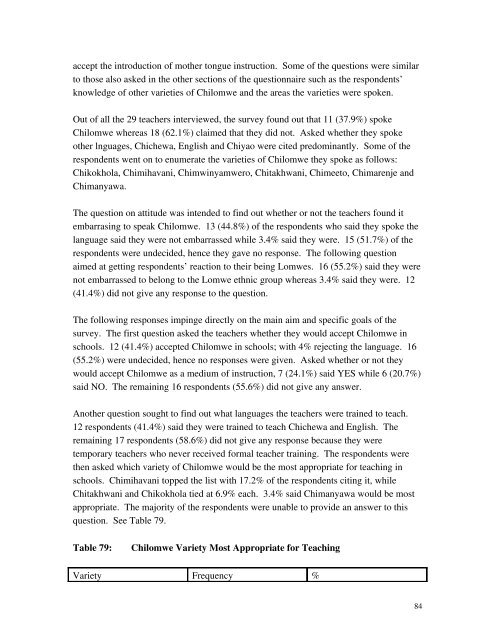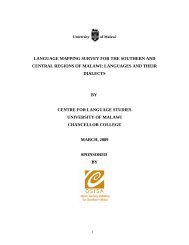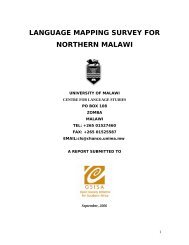SOCIOLOLINGUISTIC SURVEYS - Centre for Language Studies
SOCIOLOLINGUISTIC SURVEYS - Centre for Language Studies
SOCIOLOLINGUISTIC SURVEYS - Centre for Language Studies
Create successful ePaper yourself
Turn your PDF publications into a flip-book with our unique Google optimized e-Paper software.
accept the introduction of mother tongue instruction. Some of the questions were similar<br />
to those also asked in the other sections of the questionnaire such as the respondents’<br />
knowledge of other varieties of Chilomwe and the areas the varieties were spoken.<br />
Out of all the 29 teachers interviewed, the survey found out that 11 (37.9%) spoke<br />
Chilomwe whereas 18 (62.1%) claimed that they did not. Asked whether they spoke<br />
other lnguages, Chichewa, English and Chiyao were cited predominantly. Some of the<br />
respondents went on to enumerate the varieties of Chilomwe they spoke as follows:<br />
Chikokhola, Chimihavani, Chimwinyamwero, Chitakhwani, Chimeeto, Chimarenje and<br />
Chimanyawa.<br />
The question on attitude was intended to find out whether or not the teachers found it<br />
embarrasing to speak Chilomwe. 13 (44.8%) of the respondents who said they spoke the<br />
language said they were not embarrassed while 3.4% said they were. 15 (51.7%) of the<br />
respondents were undecided, hence they gave no response. The following question<br />
aimed at getting respondents’ reaction to their being Lomwes. 16 (55.2%) said they were<br />
not embarrassed to belong to the Lomwe ethnic group whereas 3.4% said they were. 12<br />
(41.4%) did not give any response to the question.<br />
The following responses impinge directly on the main aim and specific goals of the<br />
survey. The first question asked the teachers whether they would accept Chilomwe in<br />
schools. 12 (41.4%) accepted Chilomwe in schools; with 4% rejecting the language. 16<br />
(55.2%) were undecided, hence no responses were given. Asked whether or not they<br />
would accept Chilomwe as a medium of instruction, 7 (24.1%) said YES while 6 (20.7%)<br />
said NO. The remaining 16 respondents (55.6%) did not give any answer.<br />
Another question sought to find out what languages the teachers were trained to teach.<br />
12 respondents (41.4%) said they were trained to teach Chichewa and English. The<br />
remaining 17 respondents (58.6%) did not give any response because they were<br />
temporary teachers who never received <strong>for</strong>mal teacher training. The respondents were<br />
then asked which variety of Chilomwe would be the most appropriate <strong>for</strong> teaching in<br />
schools. Chimihavani topped the list with 17.2% of the respondents citing it, while<br />
Chitakhwani and Chikokhola tied at 6.9% each. 3.4% said Chimanyawa would be most<br />
appropriate. The majority of the respondents were unable to provide an answer to this<br />
question. See Table 79.<br />
Table 79:<br />
Chilomwe Variety Most Appropriate <strong>for</strong> Teaching<br />
Variety Frequency %<br />
84





